A Novel QoS-Aware A-MPDU Aggregation Scheduler for Unsaturated IEEE802.11n/ac WLANs
Abstract
1. Introduction
- The model is based on the aggregation level-dependent collision probability considering the gathering procedure.
- The average and variance of the access delay for transmissions using RTS/CTS mechanisms on error-prone channels are discussed and the effect on the queuing behaviors is given.
- A model for the end-to-end delay, gathering delay, queuing delay, and collisions is developed.
- An algorithm that can search for the optimal aggregation level more quickly by narrowing the candidate range of aggregation levels is proposed.
2. Background and Related Works
2.1. The A-MPDU Aggregation and Black Acknowledgement
2.2. The RTS/CTS Mechanism
2.3. Related Works
3. Methods
3.1. The End-to-End Delay
3.2. The Access Delay
4. Algorithms
- (1)
- Those aggregation levels whose is equal to 1 can be removed in advance. As the back-off procedure is executed in units of A-MPDU and the overhead of idle and conflicting slots is independent of the aggregation levels, the average service time per packet is shortened when the aggregation level increases. Consequently, is in descending order according to Equation (20), and we can locate the smallest aggregation level whose is less than 1 in advance through the binary search method.
- (2)
- According to Equation (2), the gathering delay ascends with the increase of the aggregation levels. Therefore, before the end-to-end delay is calculated, the gathering delay is compared with the best end-to-end delay at that point. If the gathering delay is greater than the currently best end-to-end delay, it is clear that the end-to-end delay containing the gathering delay is greater.
- (3)
- According to the model, and only depend on the PER and the candidate aggregation level which are limited values. Therefore, the derivation of these distributions is preferred to be implemented offline and the results are stored in a look-up table with all possible PER and L. When calculating the end-to-end delay, the algorithm can fetch the distributions from the table by indexing with given PER and L.
| Algorithm 1. Searching for the optimal aggregation level. |
| Require: { The packet arrival rate.} |
| Require: Bit error rates (BERs) in all stations{The BERs in the channel can be estimated using the signal to noise ratio (SNR).} |
| Require: N{The number of active stations in the wireless local area network (WLAN).} |
| Ensure: {The optimal aggregation level.} |
| procedure LowerBoundSearch() |
| ; |
| Calculate with aggregation level , using Equation (20); |
| if then |
| ; |
| ; |
| Calculate with aggregation level , using Equation (20); |
| if then |
| ; |
| while right - left > 1 do |
| ; |
| Calculate with aggregation level , using Equation (20); |
| if then |
| ; |
| else |
| ; |
| end if |
| end while |
| end if |
| end if |
| return |
| end procedure |
| procedureOptimalAggregationLevelSearch( ) |
| ; |
| is calculated with aggregation level L, using Equation (23); |
| whiledo |
| is calculated with aggregation level L, using Equation (23); |
| ; |
| end while |
| is calculated with aggregation level L, using Equation (1); |
| ; |
| Calculate with new aggregation level L+1, using (2); |
| while do |
| ; |
| is calculated with aggregation level L, using Equation (1); |
| if then |
| ; |
| ; |
| end if |
| Calculate with new aggregation level L+1, using Equation (2); |
| end while |
| return |
| end procedure |
5. Performance Evaluation
5.1. The Validation of the Proposed Model and Algorithm
5.2. The Performance Evaluation of the Proposed Scheduler
6. Conclusions
Author Contributions
Funding
Conflicts of Interest
References
- International Telecommunication Union. Global Information Infrastructure, Internet Protocol Aspects and Next-Generation Networks; ITU-T Y.1541. Series Y; International Telecommunication Union (ITU): Geneva, Switzerland, 2011. [Google Scholar]
- Institute of Electrical and Electronics Engineers. IEEE Standard for Information Technology-Telecommunications and Information Exchange Between Systems Local and Metropolitan Networks-Specific Requirements, Part 11: Wireless LAN Medium Access Control (MAC) and Physical Layer (PHY) Specifications; IEEE: Piscataway, NJ, USA, 2016. [Google Scholar]
- Hajlaoui, N.; Jabri, I.; Taieb, M.; Benjemaa, M. A frame aggregation scheduler for QoS-sensitive applications in IEEE 802.11n WLANs. In Proceedings of the 2012 International Conference on Communications and Information Technology (ICCIT), Hammamet, Tunisia, 26–28 June 2012; pp. 221–226. [Google Scholar]
- Seytnazarov, S.; Kim, Y.-T. QoS-Aware Adaptive A-MPDU Aggregation Scheduler for Voice Traffic in Aggregation-Enabled High Throughput WLANs. IEEE. Trans. Mob. Comput. 2017, 16, 2862–2875. [Google Scholar] [CrossRef]
- Coronado, E.; Villalón, J.; Garrido, A. Dynamic AIFSN tuning for improving the QoS over IEEE 802.11 WLANs. In Proceedings of the 2015 International Wireless Communications and Mobile Computing Conference (IWCMC), Dubrovnik, Croatia, 24–28 August 2015; pp. 73–78. [Google Scholar]
- Ruscelli, A.L.; Cecchetti, G. Improving the QoS of IEEE 802.11e networks through imprecise computation. Int. J. Ad Hoc Ubiquitous Comput. 2016, 23, 152–167. [Google Scholar] [CrossRef]
- Syed, I.; Shin, S.-H.; Roh, B.-H.; Adnan, M. Performance Improvement of QoS-Enabled WLANs Using Adaptive Contention Window Backoff Algorithm. IEEE Syst. J. 2018, 12, 3260–3270. [Google Scholar] [CrossRef]
- Zawia, H.; Hassan, R.; Dahnil, D.P. Enhancement of real-time application IEEE 802.11e using dynamics contention windows approach. Adv. Sci. Lett. 2016, 22, 1874–1881. [Google Scholar] [CrossRef]
- Tian, G.; Camtepe, S.; Yu-Chu, T. A Deadline-Constrained 802.11 MAC Protocol With QoS Differentiation for Soft Real-Time Control. IEEE Trans. Ind. Inform. 2016, 12, 544–554. [Google Scholar] [CrossRef]
- Qian, X.; Wu, B.; Ye, T.-C. QoS-Aware A-MPDU Retransmission Scheme for 802.11n/ac/ad WLANs. IEEE Commun. Lett. 2017, 21, 2290–2293. [Google Scholar] [CrossRef]
- Lee, W.H.; Hwang, H.Y. A-MPDU aggregation with optimal number of MPDUs for delay requirements in IEEE 802.11ac. PLoS ONE 2019, 14, e0213888. [Google Scholar] [CrossRef] [PubMed]
- Charfi, E.; Gueguen, C.; Chaari, L.; Cousin, B.; Kamoun, L. Dynamic Frame Aggregation Scheduler for Multimedia applications in IEEE 802.11n Networks. Trans. Emerg. Telecommun. Technol. 2015, 28, e2942. [Google Scholar] [CrossRef]
- Hajlaoui, N.; Jabri, I.; Ben Jemaa, M. An accurate two dimensional Markov chain model for IEEE 802.11n DCF. Wirel. Netw. 2018, 24, 1019–1031. [Google Scholar] [CrossRef]
- Mansour, K.; Jabri, I.; Ezzedine, T. Revisiting the IEEE 802.11n A-MPDU Retransmission Scheme. IEEE Commun. Lett. 2019, 23, 1097–1100. [Google Scholar] [CrossRef]
- Seytnazarov, S.; Choi, J.-G.; Kim, Y.-T. Enhanced Mathematical Modeling of Aggregation-Enabled WLANs with Compressed BlockACK. IEEE. Trans. Mob. Comput. 2019, 18, 1260–1273. [Google Scholar] [CrossRef]
- Karmakar, R.; Swain, P.; Chattopadhyay, S.; Chakraborty, S. Performance modeling and analysis of high throughput wireless media access with QoS in noisy channel for different traffic conditions. In Proceedings of the IEEE International Conference on Communication Systems and Networks (COMSNETS), Bangalore, India, 5–10 January 2016; pp. 1–8. [Google Scholar]
- Charfi, E.; Chaari, L.; Kamoun, L. Fairness of the IEEE 802.11n aggregation scheme for real time application in unsaturated condition. In Proceedings of the 2011 4th Joint IFIP Wireless and Mobile Networking Conference (WMNC 2011), Toulouse, France, 26–28 October 2011; pp. 1–8. [Google Scholar]
- Zhao, Q.; Tsang, D.H.K.; Sakurai, T. Modeling Nonsaturated IEEE802.11DCF Networks Utilizing an Arbitrary Buffer Size. IEEE Trans. Mob. Comput. 2011, 9, 1248–1263. [Google Scholar] [CrossRef]
- Wang, Q.; Jaffres-Runser, K.; Scharbarg, J.-L.; Fraboul, C.; Sun, Y.; Li, J.; Li, Z. A thorough analysis of the performance of delay distribution models for IEEE 802.11 DCF. Ad Hoc Netw. 2015, 24, 21–33. [Google Scholar] [CrossRef][Green Version]
- Kleinrock, L. Theory, Queueing Systems; Wiley-Interscience: New York, NY, USA, 1975; Volume 1. [Google Scholar]
- Zhao, Q.; Tsang, D.H.K.; Sakurai, T. A simple and approximate model for nonsaturated IEEE802.11 DCF. IEEE Trans. Mob. Comput. 2009, 8, 1539–1553. [Google Scholar] [CrossRef]
- Sakurai, T.; Vu, H.L. Access Delay of the IEEE802.11 MAC Protocol under Saturation. IEEE Trans. Wirel. Commun. 2007, 6, 1702–1710. [Google Scholar] [CrossRef]
- NS-3 Network Simulator. Available online: http://www.nsnam.org/ (accessed on 18 June 2020).
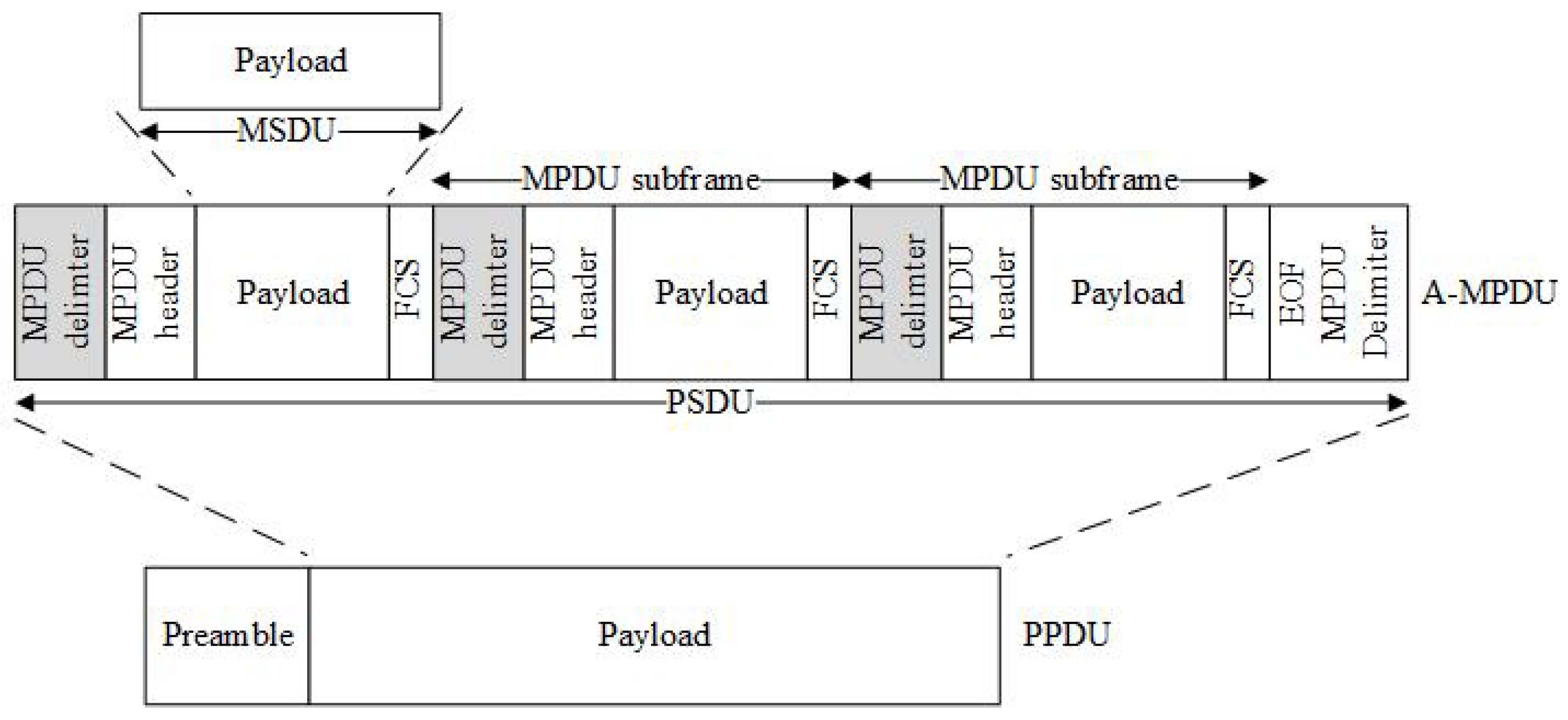






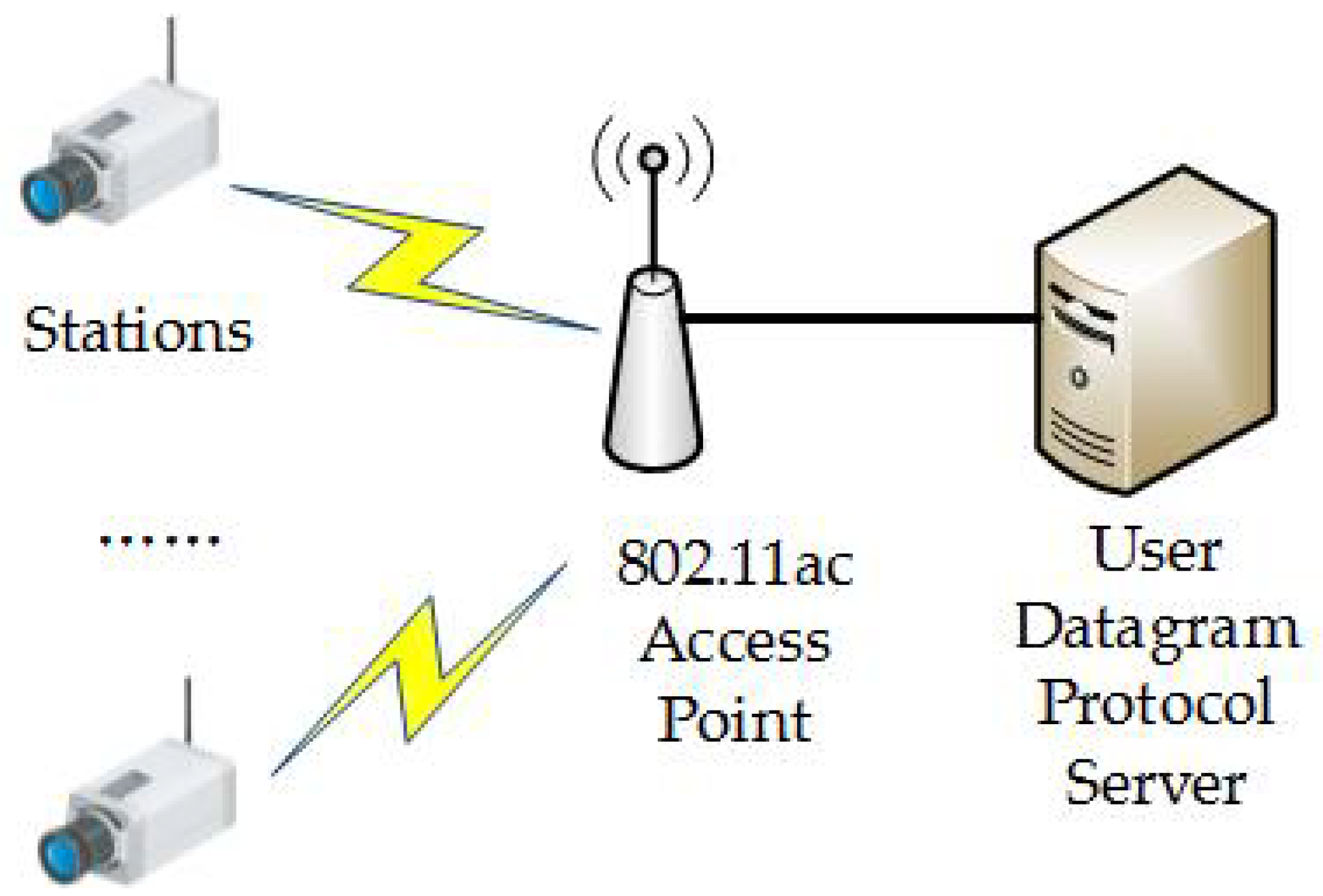
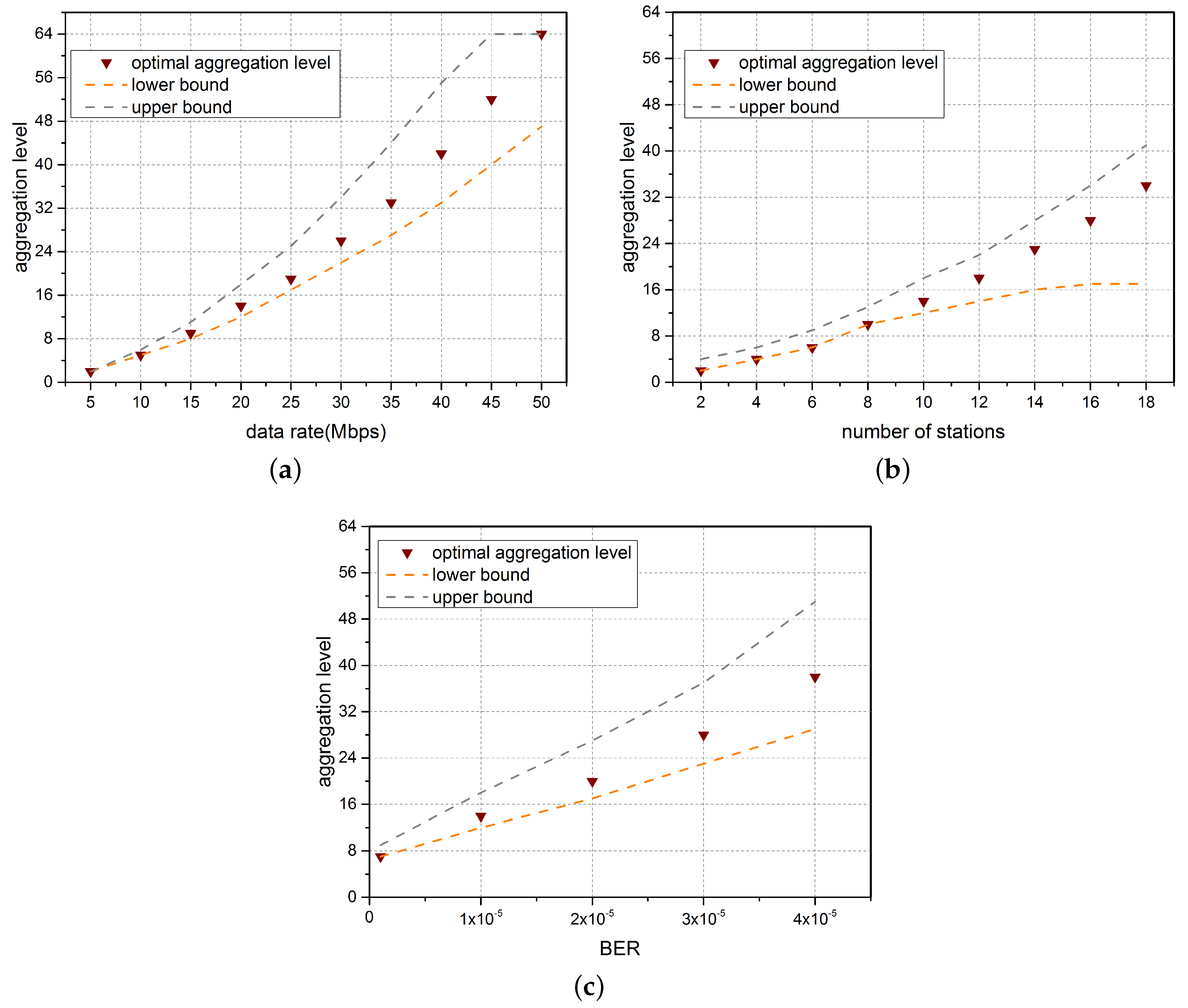


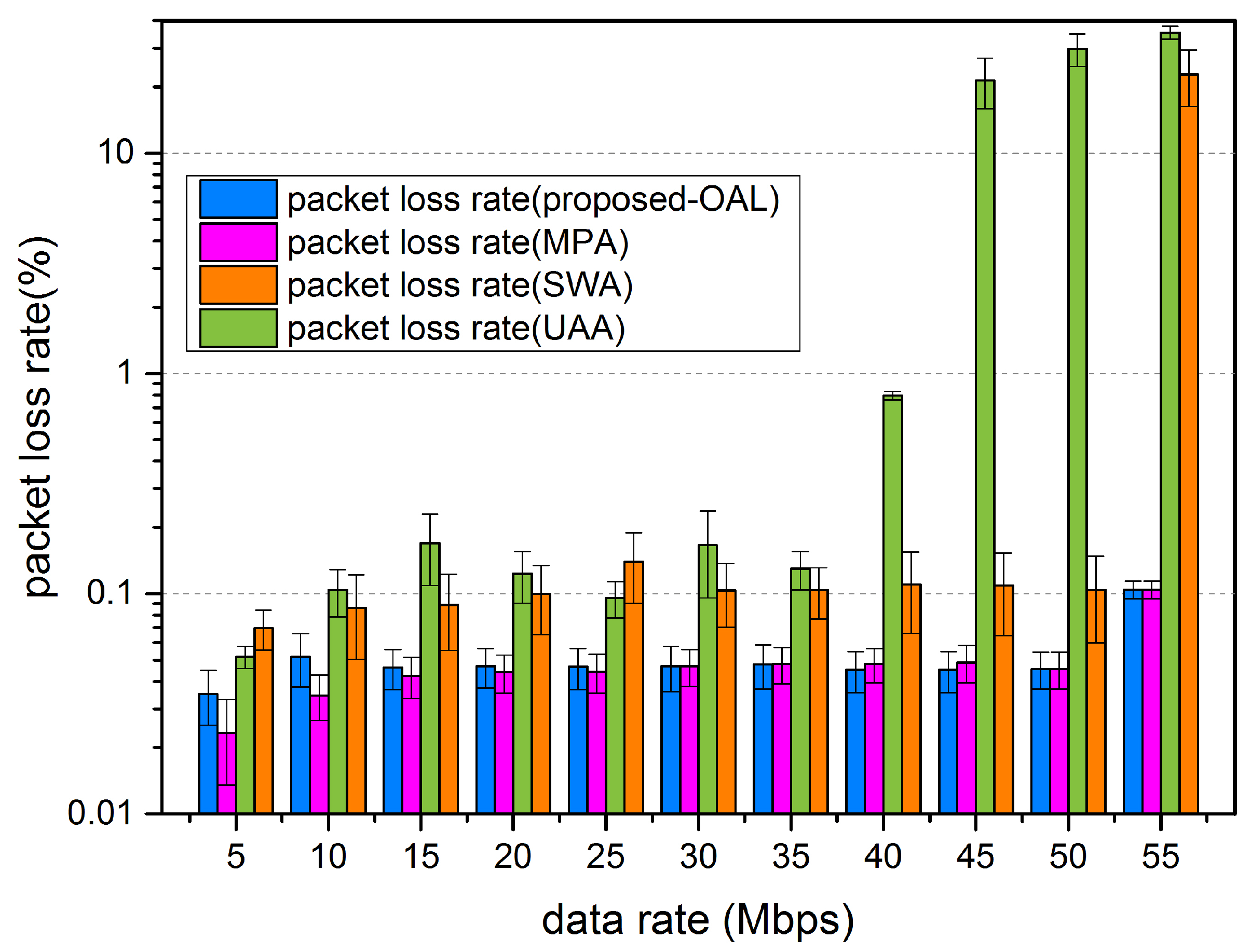

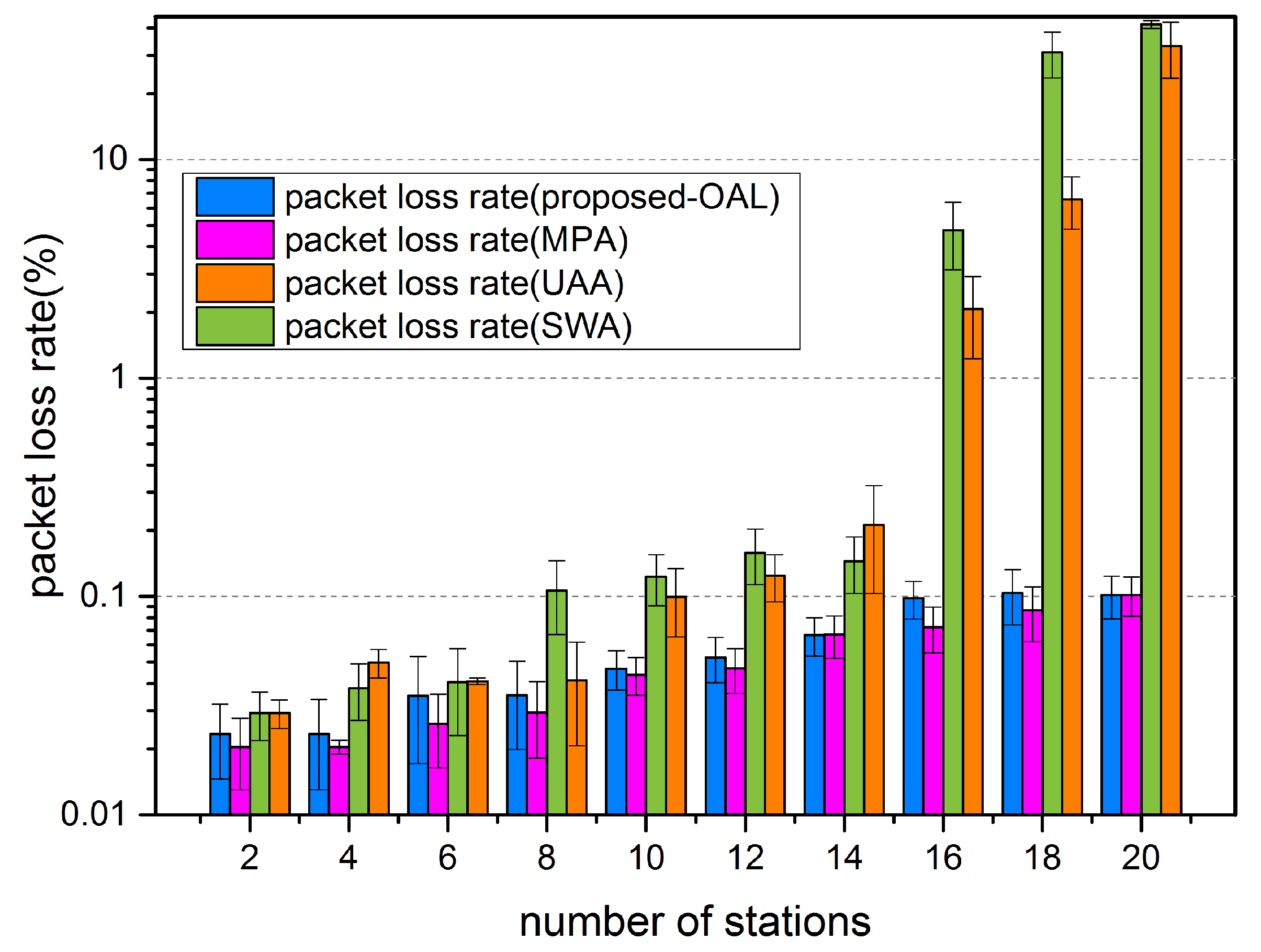
| Data Rate | Frame Rate | Average Frame Size |
|---|---|---|
| 5 Mbps | 60 fps | 10,341 bytes |
| Parameter | Value |
|---|---|
| W | 64 |
| retry limit | 4 |
| maximum back-off stage | 2 |
| minimum contention window (CW) size | 8 |
| 78 bytes | |
| 36 + 1472 bytes | |
| 9 s | |
| 43 s | |
| 16 s | |
| 32 s | |
| 76 s | |
| 48 s | |
| 42 s | |
| 44 s | |
| 76 s |
© 2020 by the authors. Licensee MDPI, Basel, Switzerland. This article is an open access article distributed under the terms and conditions of the Creative Commons Attribution (CC BY) license (http://creativecommons.org/licenses/by/4.0/).
Share and Cite
Lu, C.; Wu, B.; Ye, T. A Novel QoS-Aware A-MPDU Aggregation Scheduler for Unsaturated IEEE802.11n/ac WLANs. Electronics 2020, 9, 1203. https://doi.org/10.3390/electronics9081203
Lu C, Wu B, Ye T. A Novel QoS-Aware A-MPDU Aggregation Scheduler for Unsaturated IEEE802.11n/ac WLANs. Electronics. 2020; 9(8):1203. https://doi.org/10.3390/electronics9081203
Chicago/Turabian StyleLu, Cong, Bin Wu, and Tianchun Ye. 2020. "A Novel QoS-Aware A-MPDU Aggregation Scheduler for Unsaturated IEEE802.11n/ac WLANs" Electronics 9, no. 8: 1203. https://doi.org/10.3390/electronics9081203
APA StyleLu, C., Wu, B., & Ye, T. (2020). A Novel QoS-Aware A-MPDU Aggregation Scheduler for Unsaturated IEEE802.11n/ac WLANs. Electronics, 9(8), 1203. https://doi.org/10.3390/electronics9081203





